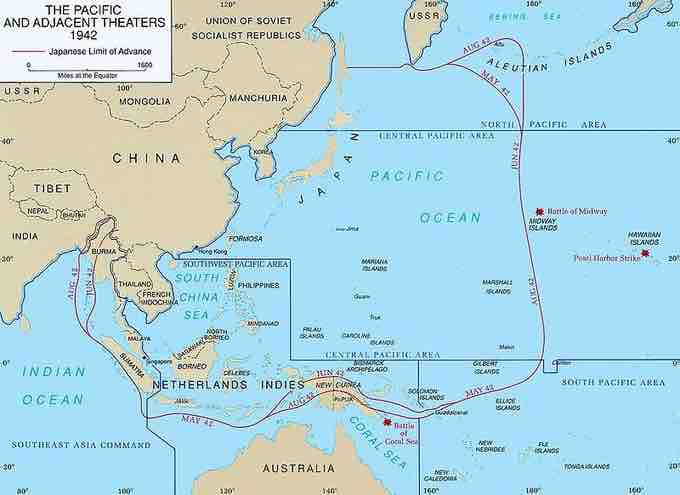The Guadalcanal Campaign, also known as the Battle of Guadalcanal and code-named Operation Watchtower, was a military campaign fought between August 7, 1942 and February 9, 1943 on and around the island of Guadalcanal in the Pacific theater of World War II. It was the first major offensive by Allied forces against the Empire of Japan.
BACKGROUND
The 1941 Japanese attack on Pearl Harbor crippled much of the U.S. battleship fleet and precipitated an open and formal state of war between the two nations. The initial goals of Japanese leaders were to neutralize the US Navy, seize possessions rich in natural resources, and establish strategic military bases to defend Japan's empire in the Pacific Ocean and Asia. To further those goals, Japanese forces captured the Philippines, Thailand, Malaya, Singapore, Burma, the Dutch East Indies, Wake Island, Gilbert Islands, New Britain and Guam. Joining the U.S. in the war against Japan were the rest of the Allied powers, several of whom, including the United Kingdom, Australia and the Netherlands, had also been attacked by Japan.
Further attempts by the Japanese to continue their strategic initiative and offensively extend their outer defensive perimeter in the south and central Pacific were thwarted at the naval battles of Coral Sea (May 1941) and Midway (June 1941) respectively. Up to this point, the Allies had been on the defensive in the Pacific but these strategic victories provided them an opportunity to seize the initiative from Japan.
The Allies chose the Solomon Islands (a protectorate of the United Kingdom), specifically the southern Solomon Islands of Guadalcanal, Tulagi and Florida Island, as the first target. The Imperial Japanese Navy had occupied Tulagi in May 1942 and had constructed a seaplane base nearby. Allied concern grew when, in early July 1942, the IJN began constructing a large airfield at Lunga Point on nearby Guadalcanal—from such a base Japanese long-range bombers would threaten the sea lines of communication from the West Coast of the Americas to the populous East Coast of Australia. By August 1942, the Japanese had about 900 naval troops on Tulagi and nearby islands and 2,800 personnel on Guadalcanal.
CAMPAIGN
On August 7, 1942, Allied forces, predominantly American, landed on the islands of Guadalcanal, Tulagi, and Florida in the southern Solomon Islands, with the objective of denying their use by the Japanese to threaten the supply and communication routes between the U.S., Australia, and New Zealand. The Allies also intended to use Guadalcanal and Tulagi as bases to support a campaign to eventually capture or neutralize the major Japanese base at Rabaul on New Britain. The Allies overwhelmed the outnumbered Japanese defenders, who had occupied the islands since May 1942, and captured Tulagi and Florida, as well as an airfield (later named Henderson Field) that was under construction on Guadalcanal. Powerful U.S. naval forces supported the landings.
Surprised by the Allied offensive, the Japanese made several attempts between August and November 1942 to retake Henderson Field. Three major land battles, seven large naval battles, and continual, almost daily aerial battles culminated in the decisive Naval Battle of Guadalcanal in early November 1942. The last Japanese attempt to bombard Henderson Field from the sea and land with enough troops to retake it was defeated. In December 1942, the Japanese abandoned further efforts to retake Guadalcanal and evacuated their remaining forces by February 7, 1943 in the face of an offensive by the U.S. Army's XIV Corps, conceding the island to the Allies.
EFFECT
The Guadalcanal campaign was a significant strategic combined arms victory by Allied forces over the Japanese in the Pacific theater. The Japanese had reached the high-water mark of their conquests in the Pacific, and Guadalcanal marked the transition by the Allies from defensive operations to the strategic offensive in that theater and the beginning of offensive operations, including the Solomon Islands, New Guinea, and Central Pacific campaigns, that resulted in Japan's eventual surrender and the end of World War II.
Perhaps as important as the military victory for the Allies was the psychological victory. On a level playing field, the Allies had beaten Japan's best land, air, and naval forces. After Guadalcanal, Allied personnel regarded the Japanese military with much less fear and awe than previously. In addition, the Allies viewed the eventual outcome of the Pacific War with greatly increased optimism.

Pacific Theater Areas
Japanese control of the western Pacific area between May and August 1942. Guadalcanal is located in the lower right center of the map.